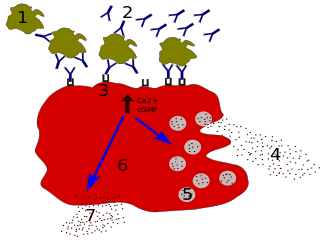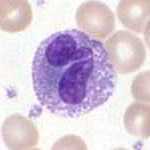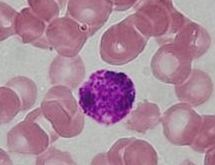Related Research Articles

Allergies, also known as allergic diseases, are various conditions caused by hypersensitivity of the immune system to typically harmless substances in the environment. These diseases include hay fever, food allergies, atopic dermatitis, allergic asthma, and anaphylaxis. Symptoms may include red eyes, an itchy rash, sneezing, coughing, a runny nose, shortness of breath, or swelling. Note that food intolerances and food poisoning are separate conditions.

Eosinophils, sometimes called eosinophiles or, less commonly, acidophils, are a variety of white blood cells and one of the immune system components responsible for combating multicellular parasites and certain infections in vertebrates. Along with mast cells and basophils, they also control mechanisms associated with allergy and asthma. They are granulocytes that develop during hematopoiesis in the bone marrow before migrating into blood, after which they are terminally differentiated and do not multiply.

A mast cell is a resident cell of connective tissue that contains many granules rich in histamine and heparin. Specifically, it is a type of granulocyte derived from the myeloid stem cell that is a part of the immune and neuroimmune systems. Mast cells were discovered by Paul Ehrlich in 1877. Although best known for their role in allergy and anaphylaxis, mast cells play an important protective role as well, being intimately involved in wound healing, angiogenesis, immune tolerance, defense against pathogens, and vascular permeability in brain tumors.

Basophils are a type of white blood cell. Basophils are the least common type of granulocyte, representing about 0.5% to 1% of circulating white blood cells. However, they are the largest type of granulocyte and how they work is not fully understood. They are responsible for inflammatory reactions during immune response, as well as in the formation of acute and chronic allergic diseases, including anaphylaxis, asthma, atopic dermatitis and hay fever. They also produce compounds that coordinate immune responses, including histamine and serotonin that induce inflammation, and heparin that prevents blood clotting, although there are less than that found in mast cell granules. Mast cells were once thought to be basophils that migrated from the blood into their resident tissues, but they are now known to be different types of cells.

Immunoglobulin E (IgE) is a type of antibody that has been found only in mammals. IgE is synthesised by plasma cells. Monomers of IgE consist of two heavy chains and two light chains, with the ε chain containing four Ig-like constant domains (Cε1–Cε4). IgE is thought to be an important part of the immune response against infection by certain parasitic worms, including Schistosoma mansoni, Trichinella spiralis, and Fasciola hepatica. IgE is also utilized during immune defense against certain protozoan parasites such as Plasmodium falciparum. IgE may have evolved as a defense to protect against venoms.

Granulocytes are cells in the innate immune system characterized by the presence of specific granules in their cytoplasm. Such granules distinguish them from the various agranulocytes. All myeloblastic granulocytes are polymorphonuclear, that is, they have varying shapes (morphology) of the nucleus ; and are referred to as polymorphonuclear leukocytes. In common terms, polymorphonuclear granulocyte refers specifically to "neutrophil granulocytes", the most abundant of the granulocytes; the other types have varying morphology. Granulocytes are produced via granulopoiesis in the bone marrow.
Omalizumab, sold under the brand name Xolair, is a medication to treat asthma, nasal polyps, urticaria (hives), and immunoglobulin E-mediated food allergy.

The interleukin 4 is a cytokine that induces differentiation of naive helper T cells (Th0 cells) to Th2 cells. Upon activation by IL-4, Th2 cells subsequently produce additional IL-4 in a positive feedback loop. IL-4 is produced primarily by mast cells, Th2 cells, eosinophils and basophils. It is closely related and has functions similar to IL-13.
Margaret J. "Margie" Profet is an American evolutionary biologist with no formal biology training who created a decade-long controversy when she published her findings on the role of Darwinian evolution in menstruation, allergies and morning sickness. She argued that these three processes had evolved to eliminate pathogens, carcinogens and other toxins from the body.

The high-affinity IgE receptor, also known as FcεRI, or Fc epsilon RI, is the high-affinity receptor for the Fc region of immunoglobulin E (IgE), an antibody isotype involved in allergy disorders and parasite immunity. FcεRI is a tetrameric receptor complex that binds Fc portion of the ε heavy chain of IgE. It consists of one alpha, one beta, and two gamma chains connected by two disulfide bridges on mast cells and basophils. It lacks the beta subunit on other cells. It is constitutively expressed on mast cells and basophils and is inducible in eosinophils.

Degranulation is a cellular process that releases antimicrobial cytotoxic or other molecules from secretory vesicles called granules found inside some cells. It is used by several different cells involved in the immune system, including granulocytes. It is also used by certain lymphocytes such as natural killer (NK) cells and cytotoxic T cells, whose main purpose is to destroy invading microorganisms.

The Annual Review of Pathology: Mechanisms of Disease is a peer-reviewed academic journal that publishes an annual volume of review articles relevant to pathology. It was established in 2006 and is published by Annual Reviews. Its co-editors have been Jon C. Aster, Mel B. Feany, and Jayanta Debnath since 2021. As of 2023, Annual Review of Pathology: Mechanisms of Disease is being published as open access, under the Subscribe to Open model. As of 2023, Journal Citation Reports gives the journal a 2022 impact factor of 36.2, ranking it first of 76 journal titles in the category "Pathology".
Eugene C. "Gene" Butcher is an American immunologist and a professor of pathology at Stanford University School of Medicine.

Basopenia (or basocytopenia) is a form of agranulocytosis associated with a deficiency of basophils. It has been proposed as an indicator of ovulation. It is difficult to detect without flow cytometry, because normal levels are so low. It can be defined as less than 0.01 x 109 / L. Basopenia has been observed in a number of conditions, including after the administration of corticosteroids and in disease states such as chronic urticaria and lupus.
The American Society for Investigative Pathology (ASIP) is a society of biomedical scientists who investigate mechanisms of disease. ASIP membership includes scientists in the academic, government, hospital, and pharmaceutical arenas that focus their research on the pathogenesis, classification, diagnosis and manifestations of disease. Research findings are ultimately used in the understanding, diagnosis and treatment of human diseases. The word pathology is derived from the Greek word "pathos" meaning "disease."

Stephen C. Harrison is professor of biological chemistry and molecular pharmacology, professor of pediatrics, and director of the Center for Molecular and Cellular Dynamics of Harvard Medical School, head of the Laboratory of Molecular Medicine at Boston Children's Hospital, and investigator of the Howard Hughes Medical Institute.

Kari C. Nadeau is the Chair of the Department of Environmental Health at Harvard School of Public Health and John Rock Professor of Climate and Population Studies. She is adjunct professor at Stanford University in the Department of Pediatrics and the co-chair of the Medical Societies Consortium for Climate Change and Health. She practices Allergy, Asthma, Immunology in children and adults. She has published over 400+ papers, many in the field of climate change and health. Her team focuses on quantifying health outcomes of solutions as they pertain climate change mitigation and adaptation at the local, regional, country, and global levels. Dr. Nadeau, with a team of individuals and patients and families, has been able to help major progress and impact in the clinical fields of immunology, infection, asthma, and allergy. Dr. Nadeau is a member of the National Academy of Medicine and the U.S. EPA Children’s Health Protection Committee.
Peter Valent is an Austrian hematologist and stem cell researcher. Since 1990 he leads a research group at the Medical University of Vienna. From 2002 he coordinates the European Competence Network on Mastocytosis and since 2008 he is Scientific Director of the Ludwig Boltzmann Institute for Hematology and Oncology of the Ludwig Boltzmann Society in Austria.
Peter Maxwell Howley is an American pathologist, virologist, and professor at Harvard Medical School. He has been president of the American Society for Virology and the American Society for Investigative Pathology and a co-editor of the Annual Review of Pathology: Mechanisms of Disease.
Jayanta Debnath is an American physician who specializes in pathology. His research focuses on autophagy as it relates to cancer. He is the chair of the University of California, San Francisco department of pathology and a co-editor of the Annual Review of Pathology: Mechanisms of Disease.
References
- 1 2 Harvard and Radcliffe School Yearbook. Cambridge, MA. 1968. p. 301.
{{cite book}}: CS1 maint: location missing publisher (link) - 1 2 "Anne Stuart, Lexington, bride of Dr. S. J. Galli". The Boston Globe. 24 March 1974. p. 68. Retrieved 21 January 2021.
- 1 2 Stephenson Carter, Laura. "Stephen Galli '70: A scientist and a limericist". Dartmouth Medicine. Retrieved 21 January 2021.
- 1 2 "Stephen J. Galli, MD". Stanford Profiles. Retrieved 21 January 2021.
- ↑ "Our Mission". Galli Lab. Retrieved 21 January 2021.
- ↑ "Annual Review of Pathology: Mechanisms of Disease. Volume 2: 2007. Edited by Abul K Abbas, , Stephen J Galli, and , Peter M Howley. Palo Alto (California): Annual Reviews. $55.00. Xii + 429 p; ill.; no index. ISBN: 978‐0‐8243‐4302‐6. 2007". The Quarterly Review of Biology. 82 (3): 311. 2007. doi:10.1086/523214.
- ↑ "Annual Review of Pathology: Mechanisms of Disease, Current Editorial Committee". Annual Reviews. Retrieved 18 January 2021.
- ↑ Sciences, CeMM Research Center for Molecular Medicine of the Austrian Academy of. "Allergic immune responses help fight bacterial infections". medicalxpress.com. Retrieved 2024-02-19.
- ↑ "Stephen J. Galli, MD, to Receive 2024 American Society for Investigative Pathology Gold-Headed Cane Award". Newswise.com. Retrieved 2024-02-24.
- 1 2 Tsai, Mindy; Chinthrajah, Sharon; Nadeau, Kari C. (2020). "Legends of Allergy: Stephen J. Galli". Allergy. 75 (1): 243–245. doi:10.1111/all.13815. PMID 30964544. S2CID 104296666.